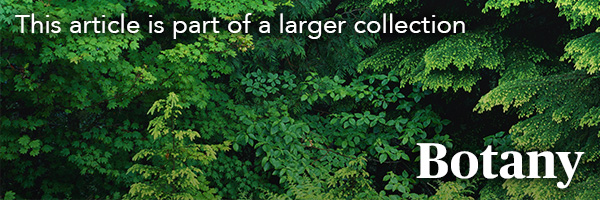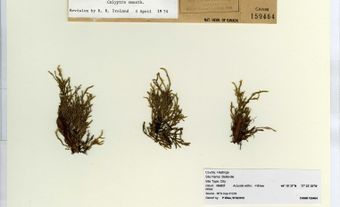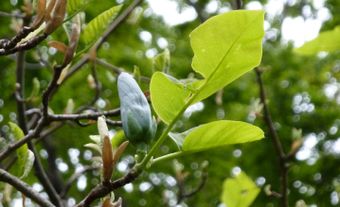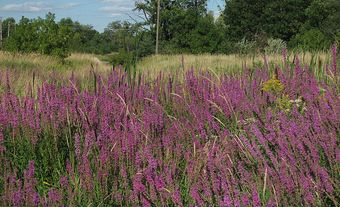Moss is a small terrestrial plant, usually less than 10 cm tall, that lacks true conducting tissues (xylem, phloem) and has a dominant gametophyte (sexual) generation. Mosses are the largest and most highly developed group of division Bryophyta (which also includes liverworts and hornworts). Bryophytes are sometimes known as the “amphibians of the plant world” because of their dependence on water for sexual reproduction. There are over 10,000 species of moss worldwide, of which about 1,250 are found in North America. Individual parts of Canada have fewer species (e.g., 466 species in Alberta, 445 in Newfoundland, 430 in Ontario). Mosses thrive in humid climates, and coastal parts of Canada have a greater diversity than the interior parts.

(artwork by Claire Tremblay)
Evolution
Many botanists believe that mosses evolved from primitive vascular plants (i.e., those having true conducting tissues). Others argue that they developed from some green algal ancestor. Mosses are thought to be a reduced group, which lost much evolutionary potential by having a dominant gametophyte generation and by lacking specialized conducting tissues (a factor limiting size).
Description and Reproduction
Mosses show alternation of generations, i.e., have two phases in the life cycle. These are the free-living, perennial gametophyte (the typical green moss plant), and the short-lived sporophyte (asexual generation), which remains dependent on the gametophyte.
The sporophyte produces spores that are wind dispersed. Some spores germinate into new gametophyte plants. Gametophyte plants produce sex cells (eggs, sperm) that undergo fertilization to produce another sporophyte. The gametophyte has rhizoids (rootlike structures that attach the plant to its substrate), a simple or branched stem, and small leaves (mostly only one cell thick). The sporophyte has a foot embedding it into the gametophyte and a spore capsule usually borne on a stalk (seta). Some mosses reproduce asexually by gemmae (small groups of cells produced on the gametophyte tissues) or by bulbils (small, deciduous shoots) found in leaf axils. Most mosses can also reproduce by fragmentation, i.e., the breaking off of almost any plant part, which then grows into a new plant. Lacking true conducting tissues, mosses mostly absorb water directly through the stem and leaves.
Mosses occur in several growth forms, the more common being turfs, cushions, mats and wefts. Individual plants are usually closely associated and several hundreds may be found in a single turf or cushion.
Did you know?
The one plant that is considered extinct in Canada is a moss. Called Macoun’s shining moss (Neomacounia nitida), it was named for John Macoun, a self-taught botanist who collected the plant near his home in Belleville, Ontario, between 1862 and 1864. The moss has not been recorded since. The Committee on the Status of Endangered Wildlife in Canada designated Macoun’s shining moss extinct in 2002. (See also Extinct Plants in Canada.)
Habitat
Mosses grow in many places but prefer moist, shady habitats. A few are aquatic (especially water mosses, genus Fontinalis); some grow in very dry places (especially granite mosses, Andreaea). Common growth surfaces include rocks, trees, rotten wood, humus and soil. The presence of copper mosses may indicate high levels of heavy metals in the substrates. Dung mosses grow only on dung or other nitrogen-rich substrates. Peat mosses (genus Sphagnum) accumulate into deposits that may be several hundred metres thick. Peat is used in horticulture and as fuel. Mosses, an important part of the ground cover in the boreal coniferous forests, are also a conspicuous part of arctic tundra or mountain vegetation. Some mosses are good pioneer colonizers and quickly invade bare or disturbed soil, consolidating it by their dense, turflike growth.

 Share on Facebook
Share on Facebook Share on X
Share on X Share by Email
Share by Email Share on Google Classroom
Share on Google Classroom




